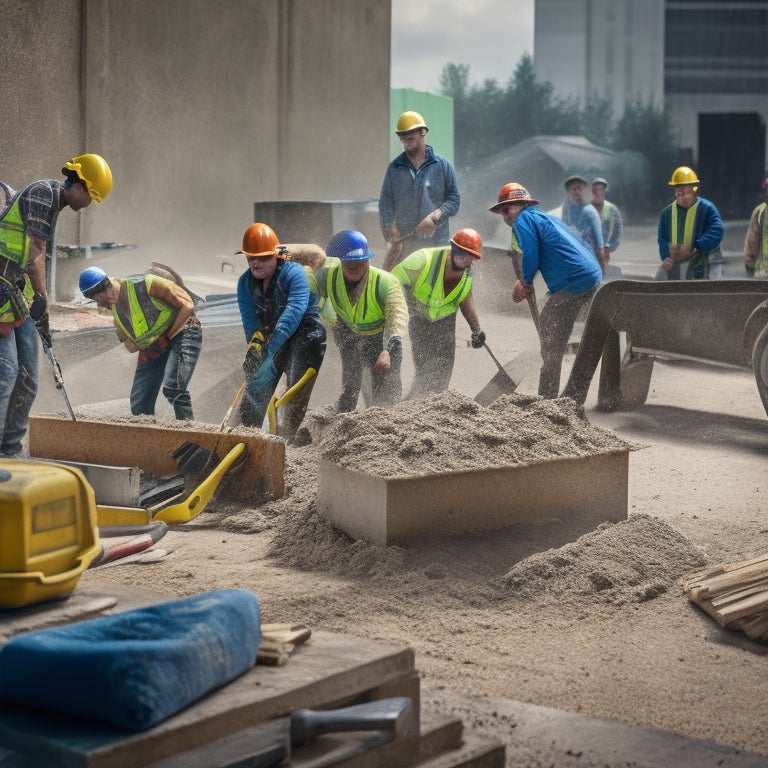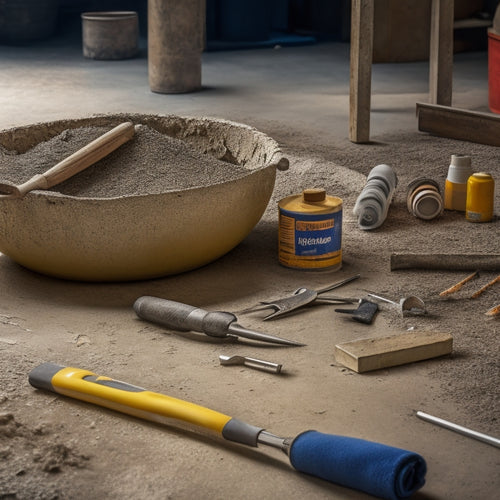
Top Hand Tools for Concrete Slab Pouring
Share
When pouring a concrete slab, you'll need the right hand tools to achieve a professional-looking finish. Essential tamping tools include bull floats, hand tampers, and tamping rods to guarantee compacted joints and a crack-free finish. For a smooth finish, use edging tools, jointing tools, and floating tools that remove imperfections. Measure and mark your pour area accurately with tapes, levels, and stakes, and define edges with edgers and jointers. Trowels, hand floats, and cleanup tools like brooms and shovels are also must-haves. With these top hand tools, you'll be well on your way to achieving a high-quality concrete slab - and there's more to learn about using them to get the best results.
Key Takeaways
• Use bull floats, hand tampers, and tamping rods to compact and smooth concrete immediately after pouring for a crack-free finish.
• Edging tools, jointing tools, and floating tools are essential for achieving a smooth, polished appearance and preventing cracks.
• Measuring and marking tools like tape measures, marking techniques, and leveling tools help ensure accurate measurements and defined pour areas.
• Trowels, hand floats, and finishing tools are necessary for applying cement paste, feathering edges, and achieving a smooth, even finish.
• Cleanup and removal tools like brooms, shovels, and tamping tools are crucial for removing excess material, compacting surfaces, and preparing for finishing.
Essential Tamping Tools for Slabs
When pouring a concrete slab, what's the key to achieving a strong, even finish? Proper tamping, and that begins with the right tools in your arsenal.
You'll need a variety of tampers to guarantee a solid, compacted surface. Start with a bull float, which is used to flatten and smooth the surface immediately after pouring. Its long handle and wide blade allow you to cover large areas quickly.
Next, use a hand tamper or tamping rod to compact the concrete in smaller areas, such as along walls or around obstructions. These tools help eliminate air pockets and guarantee the concrete settles evenly.
Effective tamping techniques involve working in sections, using slow, deliberate strokes to compact the concrete.
Proper surface preparation is also essential, as it sets the stage for a successful pour. Make sure the subgrade is level, clean, and compacted before pouring the concrete.
Finishing Tools for Smooth Finish
When you're working towards a smooth finish on your concrete slab, you'll need to focus on three key areas:
edging and jointing,
tamping and screeding,
and floating and finishing.
You'll use specialized tools for each of these stages to guarantee a high-quality result.
Edging and Jointing Tools
Finish your concrete slab pouring process with precision using edging and jointing tools, essential for achieving a smooth, professional-looking finish.
These tools help you create a clean, well-defined edge treatment and joint stabilization, giving your concrete slab a polished appearance.
To get the job done, you'll need the following edging and jointing tools:
-
Edgers: used to create a smooth, rounded edge on your concrete slab.
-
Jointers: used to create control joints in your concrete slab, preventing cracks and ensuring joint stabilization.
-
Joint tamping tools: used to compact and settle aggregate in the joint, ensuring a solid bond between the slab and the joint.
-
Edge cutters: used to cut and shape the edge of your concrete slab to your desired design.
-
Edge floats: used to finish and smooth out the edge of your concrete slab, leaving a professional-looking finish.
Tamping and Screeding
You'll achieve a smooth, even finish by employing tamping and screeding tools, which compress and level the concrete to eliminate air pockets and excess water. These finishing tools are vital for a professional-looking slab.
When it comes to tamping, you'll use a tamper or a bull float to compact the concrete, ensuring it's dense and even. This step is important, as it prevents settlement cracks and strengthens the slab. To master tamping techniques, start by working in small sections, using long, smooth strokes to push the tamper forward. Apply moderate pressure, increasing it as needed to achieve the desired density.
For screeding, you'll use a screed board or a power screed to level the concrete. Screeding methods involve striking off excess concrete and filling low spots to create a uniform surface. To achieve ideal results, use a screed board with a curved or angled edge to push excess concrete forward, and then use a straight edge to level the surface.
Floating and Finishing
After achieving a well-compacted and leveled surface through tamping and screeding, it's time to further refine the concrete slab's finish using floating and finishing tools.
You'll need to employ various floating techniques to remove any imperfections and create a smooth surface. This is where finishing methods come into play.
To achieve a high-quality finish, you'll need the right tools. Here are some essential hand tools for floating and finishing:
-
Float Blades: Used for removing excess water and smoothing out the surface.
-
Bull Floats: Ideal for large, flat areas, these tools help to remove imperfections and create a uniform finish.
-
Hand Floats: Perfect for smaller areas, these tools provide more control and precision.
-
Tamping Tools: Used to compact and level the surface, ensuring a solid foundation for the final finish.
-
Edger Tools: Designed for creating clean, defined edges and joints.
Measuring and Marking Essentials
Measure the slab area accurately to guarantee precise concrete coverage, taking into account any obstructions, irregularities, or curved edges that may affect the pour.
To achieve this, you'll need to employ effective measuring techniques and utilize the right marking tools. Start by using a 100-foot tape measure or a laser distance meter to calculate the slab's length, width, and any irregularities.
Next, mark the area using a chalk line or marking paint, making sure you account for any obstructions or curved edges. When marking, use a level to make certain your lines are straight and even.
For more complex pours, consider using a total station or GPS equipment to gather precise measurements. Additionally, utilize a string line and stakes to mark the slab's edges and define the pour area.
Concrete Edging and Jointing Tools
Form clean, defined edges and precise joints in your concrete slab by employing the right edging and jointing tools, which are essential for preventing cracks and guaranteeing a professional finish.
These tools help you achieve a smooth, even surface that's free from imperfections. When it comes to concrete edging, you'll need tools that can create a clean, sharp edge along the perimeter of your slab.
Here are some must-have edging and jointing tools for your concrete slab pouring project:
-
Edger: A handheld tool used to create a clean, defined edge along the perimeter of your slab.
-
Jointer: A tool used to create precise joints in your concrete slab, helping to prevent cracks and guarantee a professional finish.
-
Groover: A tool used to create a groove in your concrete slab, which helps to control cracking and improve the overall appearance of your finish.
-
Chisel: A tool used to remove excess concrete and create a clean, defined edge.
-
Tamping tool: A tool used to compact and settle the concrete in your joints, guaranteeing a solid, crack-free finish.
Trowels for Concrete Finishing
With your concrete slab's edges and joints properly defined, you can now focus on achieving a smooth, even finish using the right trowels for concrete finishing. There are several trowel types to choose from, each suited for specific finishing tasks.
For instance, a flat trowel is ideal for applying a layer of cement paste to the surface, while a curved trowel is better suited for feathering edges and creating a smooth connection between the slab and surrounding surfaces.
When selecting a trowel, consider the handle material, blade shape, and size. A high-quality trowel will provide a comfortable grip, allowing you to work efficiently and effectively.
Proper trowel maintenance is also essential to guarantee peak performance. Regularly clean and inspect your trowel for signs of wear, and replace the blade as needed. Additionally, store your trowel in a dry place to prevent rust or corrosion.
Hand Floats for Surface Leveling
As you progress to the next stage of concrete finishing, you'll need to reach for a hand float to level the surface, knocking down high spots and filling in low areas to achieve a uniform plane. This vital step guarantees a smooth, even finish, and proper hand float techniques are essential for success.
Here are some surface leveling tips to keep in mind:
-
Hold the hand float at a 45-degree angle to the surface, using your body weight to apply pressure.
-
Use long, sweeping strokes to cover large areas, working in sections to maintain even coverage.
-
Focus on knocking down high spots first, then fill in low areas with fresh concrete.
-
Avoid applying too much pressure, which can create air pockets or displace aggregate.
-
Use a 'sawing' motion to remove excess concrete and achieve a smooth finish.
Chiseling and Breaking Tools
You'll need to switch to chiseling and breaking tools to remove excess concrete, correct mistakes, or demolish existing slabs. Selecting the right tool for the task at hand is essential.
When it comes to chiseling, you'll want to choose the appropriate tool based on the type of concrete and the desired outcome. For instance, a flat chisel is ideal for removing thin layers of concrete, while a pointed chisel is better suited for breaking up thicker sections. Mastering various chiseling techniques, such as using a gentle tapping motion or applying more forceful blows, will also help you achieve the desired results.
For breaking methods, you'll need to evaluate the type of break you're trying to achieve. A sledgehammer or demolition hammer is often used for breaking up large sections of concrete, while a pry bar or wrecking bar can be used for more precise breaking.
It's also important to assess the safety implications of each tool and technique, ensuring you're wearing proper protective gear and taking necessary precautions to avoid injury.
Cleanup and Removal Tools
When you're finished pouring the concrete slab, you'll need to clean up the site and remove any excess material, debris, and residue.
You'll be using specialized hand tools to get the job done efficiently and effectively.
In this section, we'll explore the essential cleanup and removal tools you'll need to remove excess material, break up debris, and scrape off residue.
Remove Excess Material
Remove excess material and debris from the slab area using specialized cleanup and removal tools to secure a smooth, even surface. This vital step in concrete slab pouring guarantees that your final product meets the desired quality standards. Effective removal techniques require the right tools for the job.
Here are some essential hand tools you'll need to remove excess material:
-
Brooms and brushes: Sweeps and brushes are used to remove loose debris and dust from the slab area.
-
Shovels and scoops: These tools are used to remove larger chunks of excess material and debris.
-
Tamping tools: Tamping tools, such as hand tampers or plate compactors, help to compact and smooth out the surface.
-
Edgers and jointers: These tools are used to remove excess material from edges and joints, securing a clean and even finish.
-
Dustpans and hand vacs: These tools are used to remove fine dust and debris from the slab area, leaving it clean and ready for the next step.
Break Up Debris
Your cleanup and removal tools are vital for breaking up debris, as they enable you to efficiently disintegrate and extract unwanted material from the slab area. Effective debris management is significant to guarantee a smooth and even concrete pour.
You'll need a combination of hand tools to tackle this task. A demolition hammer or breaker is ideal for breaking up large chunks of debris, while a pry bar can be used to dislodge smaller pieces. A shovel or scoop is necessary for removing the debris from the slab area.
When it comes to cleanup strategies, it's important to prioritize efficiency and safety. You should always wear protective gear, including gloves, safety glasses, and a dust mask, to prevent injury from flying debris.
Start by breaking up the largest pieces of debris, working your way down to smaller fragments. This will make removal easier and more efficient.
Scrape Off Residue
With the debris cleared, you'll need to scrape off any remaining residue, such as old adhesive, paint, or dirt, to secure a strong bond between the new concrete and the slab. This essential step in surface preparation guarantees a smooth and even finish.
To achieve this, you'll need the right tools for residue removal. Here are some important hand tools for scraping off residue:
-
Putty knives: Ideal for removing old adhesive, paint, or other sticky substances.
-
Scrapers: Used for removing dirt, grime, and other debris that may be stuck to the slab.
-
Wire brushes: Effective for removing rust, corrosion, or other stubborn residue.
-
Chisels: Handy for breaking up and removing old concrete or mortar.
-
Sandpaper or sanding blocks: Used for smoothing out the surface, removing any remaining residue, and creating a surface ready for the new concrete pour.
Frequently Asked Questions
What Personal Protective Equipment Is Necessary for Concrete Slab Pouring?
When pouring concrete slabs, you'll need personal protective equipment like safety goggles to shield your eyes from debris and chemical splashes, and work gloves to prevent skin irritation and improve grip on tools.
How Often Should Hand Tools Be Cleaned and Maintained?
'Wow, you're still using that rusty trowel from the Clinton administration? Clean and maintain your hand tools daily, or at least after every use, to prevent rust and guarantee peak performance; check for damage, lubricate moving parts, and store properly.'
Can I Use the Same Tools for Different Types of Concrete Mixes?
You'll need to take into account tool compatibility when working with mix variations, as some tools might not be suitable for all types of concrete; it's crucial to research and understand the specific requirements for each mix to guarantee ideal results.
Are There Any Specific Storage Requirements for Hand Tools?
Will you really be able to find what you need when you need it? You're wise to contemplate tool organization and storage conditions, ensuring your hand tools remain in top shape by protecting them from extreme temperatures and moisture.
How Do I Prevent Rust on Metal Hand Tools in Humid Environments?
To prevent rust on metal hand tools in humid environments, you'll want to employ rust prevention techniques like applying metal tool coatings, such as chrome or nickel plating, and regularly cleaning and drying tools after use.
Conclusion
You've made it to the finish line, and your concrete slab is starting to take shape.
Now, it's time to put the final touches on your masterpiece.
Remember, having the right hand tools is like having a trusty sidekick - they've got your back when it counts.
With these high-quality tools, you'll be pouring concrete slabs like a pro, and your finished product will be as smooth as silk.
Related Posts
-

What Tools Do I Need for Concrete Wall Repair
As you prepare for a concrete wall repair job, you'll need a variety of tools to guarantee a successful outcome. Star...
-

Top Tools for Repairing Cracked Concrete Surfaces
When tackling a cracked concrete surface repair, you'll need the right tools to guarantee a durable fix. Start with e...
-

Free Design Tools for Concrete House Planning
You can kick-start your concrete house planning project without breaking the bank, as there are several free design t...


